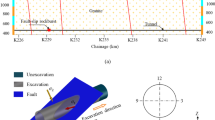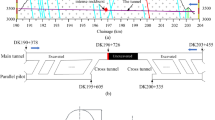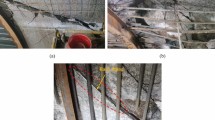Abstract
Faults can represent adverse geological conditions that frequently cause the jamming of tunnel boring machines (TBMs). In this study, we present a case study of TBM jamming at mileage 106 + 402.8 in the TBM 2 bid section of the Central Yellow River Diversion in China. Firstly, we identify possible jamming hazards. In addition, a fault between dolomitic limestone and granite was revealed by the geological investigation. Secondly, by comprehensively analyzing the geochemical, mineralogical, and microstructural characteristics of the host and fault rocks, we identify the compressional torsional fault FT2 and the nearby fault rocks. Finally, we explore how the geological characteristics of the fault rocks affect the likelihood of TBM jamming. Our results indicate that geochemical effects and long-term tectonic stresses caused major changes in the structure and composition of the migmatitic granite host rock; the fault rocks exhibit mylonitization and cataclastic breccia fabrics. Hydrothermal fluid alteration transformed the biotite and plagioclase into chlorite. In addition to the precipitation of carbon-rich fluids, which resulted in the formation of graphite, the weaknesses of these fault rocks were compounded by the presence of clay minerals and their obvious cataclastic structures. The comprehensive effect of the geological characteristics of fault rock, geological structure, ground stress, and TBM excavation unloading leads to collapse and large deformation of the weak rock in the fault zone as the main geological reason for the TBM jamming; the corresponding engineering treatment measures and recommendations are proposed. This case aims to provide reference and learning for avoiding the re-occurrence of similar jamming accidents.






taken from the FT2 fault









Similar content being viewed by others
Code availability
No code was included in this paper.
References
Abd Elmola A, Charpentier D, Buatier M, Lanari P, Monié P (2017) Textural-chemical changes and deformation conditions registered by phyllosilicates in a fault zone (Pic de Port Vieux thrust, Pyrenees). Appl Clay Sci 144:88–103
Aydan Ö, Hasanpour R (2019) Estimation of ground pressures on a shielded TBM in tunneling through squeezing ground and its possibility of jamming. Bull Eng Geol Env 78:5237–5251
Bayati M, Khademi Hamidi J (2017) A case study on TBM tunnelling in fault zones and lessons learned from ground improvement. Tunn Undergr Space Technol 63:162–170
Bejari H, Khademi Hamidi J (2018) A parametric study of two solutions for TBM jamming problem in squeezing ground conditions. Int J Civ Eng Tech 9:862–878
Bilgin N (2016) An appraisal of TBM performances in Turkey in difficult ground conditions and some recommendations. Tunn Undergr Space Technol 57:265–276
Bradbury KK, Davis CR, Shervais JW, Janecke SU, Evans JP (2015) Composition, alteration, and texture of fault-related rocks from SAFOD core and surface outcrop analogs: evidence for deformation processes and fluid-rock interactions. Pure Appl Geophys 172:1053–1078
Cao SY, Neubauer F (2019) Graphitic material in fault zones: implications for fault strength and carbon cycle. Earth Sci Rev 194:109–124
Chen JY, Yang XS, Ma SL, Spiers C (2013) Mass removal and clay mineral dehydration/rehydration in carbonate-rich surface exposures of the 2008 Wenchuan earthquake fault: geochemical evidence and implications for fault zone evolution and coseismic slip: mass removal and clay transformation. J Geophys Res Solid Earth 118
Chen ZQ, He C, Yang WB, Guo WQ, Li Z, Xu GW (2020) Impacts of geological conditions on instability causes and mechanical behavior of large-scale tunnels: a case study from the Sichuan-Tibet highway, China. Bull Eng Geol Env 79:3667–3688
Chester F, Evans J, Biegel R (1993) Internal structure and weakening mechanisms of the San Andreas Fault. J Geophys Res 98:771–786
Craw D, Upton P (2014) Graphite reaction weakening of fault rocks, and uplift of the Annapurna Himal, central Nepal. Geosphere 10:720–731
Crespo Feo E, Luque J, Barrenechea J, Rodas M (2005) Mechanical graphite transport in fault zones and the formation of graphite veins. Mineralogical Magazine - MINER MAG 69:463–470
Duan QB, Yang XS, Ma SL, Chen JY, Chen JY (2016) Fluid–rock interactions in seismic faults: implications from the structures and mineralogical and geochemical compositions of drilling cores from the rupture of the 2008 Wenchuan earthquake, China. Tectonophysics 666:260–280
Farrokh E, Rostami J (2009) Effect of adverse geological condition on TBM operation in Ghomroud tunnel conveyance project. Tunn Undergr Space Technol 24:436–446
Haertel M, Herwegh M, Pettke T (2013) Titanium-in-quartz thermometry on synkinematic quartz veins in a retrograde crustal-scale normal fault zone. Tectonophysics 608:468–481
Haines SH, van der Pluijm BA (2012) Patterns of mineral transformations in clay gouge, with examples from low-angle normal fault rocks in the western USA. J Struct Geol 43:2–32
Hasanpour R, Rostami J, Schmitt J, Ozcelik Y, Sohrabian B (2020) Prediction of TBM jamming risk in squeezing grounds using Bayesian and artificial neural networks. Journal of Rock Mechanics and Geotechnical Engineering 12:21–31
Hirono T, Fujimoto K, Yokoyama T, Hamada Y, Tanikawa W, Tadai O, Mishima T, Tanimizu M, Lin WR, Soh W, Song SR (2008) Clay mineral reactions caused by frictional heating during an earthquake: an example from the Taiwan Chelungpu fault. Geophys Res Lett 35:L16303
Holdsworth RE, van Diggelen EWE, Spiers CJ, de Bresser JHP, Walker RJ, Bowen L (2011) Fault rocks from the SAFOD core samples: implications for weakening at shallow depths along the San Andreas Fault, California. J Struct Geol 33:132–144
Isaacs A, Evans J, Song SR, Kolesar P (2007) Structural, mineralogical, and geochemical characterization of the Chelungpu Thrust Fault, Taiwan. Terrestrial Atmospheric and Oceanic Sciences - TERR ATMOS OCEAN SCI 18
Janssen C, Kanitpanyacharoen W, Wenk HR, Wirth R, Morales L, Rybacki E, Kienast M, Dresen G (2012) Clay fabrics in SAFOD core samples. J Struct Geol 43:118–127
Janssen C, Wirth R, Wenk HR, Morales L, Naumann R, Kienast M, Song SR, Dresen G (2014) Faulting processes in active faults – evidences from TCDP and SAFOD drill core samples. J Struct Geol 65:100–116
Kuo LW, Li HB, A.F. Smith S, Toro DG, Suppe J, Song SR, Nielsen S, Sheu HS, Si JL (2014) Gouge graphitization and dynamic fault weakening during the 2008 Mw 7.9 Wenchuan earthquake. Geol 42:47–50
Kuo LW, Song SR, Yeh EC, Chen HF (2009) Clay mineral anomalies in the fault zone of the Chelungpu Fault, Taiwan, and their implications. Geophys Res Lett 36
Li HB, Wang H, Xu ZQ, Si JL, Pei JL, Li TF, Huang Y, Song SR, Kuo LW, Sun ZM, Chevalier ML, Liu DL (2013) Characteristics of the fault-related rocks, fault zones and the principal slip zone in the Wenchuan Earthquake Fault Scientific Drilling Project Hole-1 (WFSD-1). Tectonophysics 584:23–42
Li SC, Xu ZH, Huang X, Lin P, Zhao XC, Zhang QS, Yang L, Zhang X, Sun HF, Pan DD (2018) Classification, geological identification, hazard mode and typical case studies of hazard-causing structures for water and mud inrush in tunnels. J Rock Mec Eng 37:1041–1069 (in Chinese)
Liao CZ, Zhang YQ, Wen CS (2007) Structural styles of the eastern boundary zone of the Ordos Basin and its regional tectonic significance. Acta Geologica Sinica:466–474 (in Chinese)
Lin A (2005) Meso and microstructural analysis of coseismic shear zone of the 1999 MW 7.6 Chi-Chi Earthquake. Taiwan Bulletin of the Seismological Society of America - BULL SEISMOL SOC AMER 95:486–501
Lin DM, Yuan RM, Shang YJ, Bao WX, Wang KY, Zhang ZJ, Li K, He WT (2017) Deformation and failure of a tunnel in the restraining bend of a strike–slip fault zone: an example from Hengshan Mountain, Shanxi Province, China. Bull Eng Geol Env 76:263–274
Liu QS, Liu H, Huang X, Pan YC, Luo CY, Sang HM (2019) Inverse analysis approach to identify the loads on the external TBM shield surface and its application. Rock Mech Rock Eng 52:3241–3260
Lyu M, Cao SY, Neubauer F, Li JY, Cheng XM (2020) Deformation fabrics and strain localization mechanisms in graphitic carbon-bearing rocks from the Ailaoshan-Red River strike-slip fault zone. J Struct Geol 140:104150
Matsuda T, Arai T, Ikeda R, Omura K, Kobayashi K, Sano H, Sawaguchi T, Tanaka H, Tomita T, Tomida N, Hirano S, Ymazaki A (2001) Examination of mineral assemblage and chemical composition in the fracture zone of the Nojima Fault at a depth of 1140 m: analyses of the Hirabayashi NIED drill cores. Island Arc 10:422–429
Matsuda T, Omura K, Ikeda R, Arai T, Kobayashi K, Shimada K, Tanaka H, Tomita T, Hirano S (2004) Fracture-zone conditions on a recently active fault: insights from mineralogical and geochemical analyses of the Hirabayashi NIED drill core on the Nojima fault, southwest Japan, which ruptured in the 1995 Kobe earthquake. Tectonophysics 378:143–163
Moore DE, Lockner DA (2008) Talc friction in the temperature range 25°–400 °C: relevance for Fault-Zone Weakening. Tectonophysics 449:120–132
Nakamura Y, Oohashi K, Toyoshima T, Satish-Kumar M, Akai J (2015) Strain-induced amorphization of graphite in fault zones of the Hidaka metamorphic belt, Hokkaido, Japan. J Struct Geol 72:142–161
Niwa M, Shimada K, Ishimaru T, Tanaka Y (2019) Identification of capable faults using fault rock geochemical signatures: a case study from offset granitic bedrock on the Tsuruga Peninsula, central Japan. Engineering Geology 260:105235
Numelin T, Marone C, Kirby E (2007) Frictional properties of natural fault gouge from a low-angle normal fault, Panamit Valley, California. Tectonics 26
Oohashi K, Hirose T, Kobayashi K, Shimamoto T (2012) The occurrence of graphite-bearing fault rocks in the Atotsugawa fault system, Japan: origins and implications for fault creep. J Struct Geol 38:39–50
Oohashi K, Hirose T, Shimamoto T (2011) Shear-induced graphitization of carbonaceous materials during seismic fault motion: experiments and possible implications for fault mechanics. J Struct Geol 33:1122–1134
Peng JB, Ma RY, Shao TQ (2004) Basic relation between structural geology and engineering geology. Earth Science Frontiers:535–549 (in Chinese)
Schleicher A, Sutherland, Townend, Toy V, Van der Pluijm B (2015) Clay mineral formation and fabric development in the DFDP-1B borehole, central Alpine Fault, New Zealand New Zealand. J Geol Geophys 58
Schleicher A, Tourscher S, Van der Pluijm B, Warr L (2009) Constraints on m-ineralization, fluid-rock interaction, and mass transfer during faulting at 2–3 km depth from the SAFOD drill hole. J Geophys Res 114
Scholz C (1987) Wear and gouge formation in brittle faulting. Geology 15:493–495
Shang YJ, Xue JH, Wang SJ, Yang ZF, Yang J (2004) A case history of tunnel boring machine jamming in an inter-layer shear zone at the Yellow River Diversion Project in China. Eng Geol 71:199–211
Sun Y, Xu SJ, Liu DL, Lin AM, Lu JJ (1998) An introduction of tectono-geochemistry in fault zones. Science Press (in Chinese)
Tanaka H, Fujimoto K, Ohtani T, Ito H (2001) Structural and chemical characterization of shear zones in the freshly activated Nojima fault, Awaji Island, southwest Japan. J Geophys Res Solid Earth 106:8789–8810
Trincal V, Charpentier D, Buatier MD, Grobety B, Lacroix B, Labaume P, Sizun J-P (2014) Quantification of mass transfers and mineralogical transformations in a thrust fault (Monte Perdido thrust unit, southern Pyrenees, Spain). Mar Pet Geol 55:160–175
Wang Q, Xin X, Jiang B, Sun HB, Xiao YC, Bian WH, Li LN (2020) Comparative experimental study on mechanical mechanism of combined arches in large section tunnels. Tunn Undergr Space Technol 99: 103386
Warr L, Cox S (2001) Clay mineral transformations and weakening mechanisms along the Alpine Fault, New Zealand. Geol Soc London Spec Publ 186:85–101
Williams JN, Toy VG, Smith SAF, Boulton C (2017) Fracturing, fluid-rock interaction and mineralisation during the seismic cycle along the Alpine Fault. J Struct Geol 103:151–166
Xu ZH, Lin P, Xing HL, Wang J (2020b) Mathematical modelling of cumulative erosion ratio for suffusion in soils. P I Civil Eng-Geotec 174: 241-251
Xu ZH, Liu FM, Lin P, Shao RQ, Shi XS (2021c) Non-destructive in-situ fast identification of adverse geology in tunnels based on anomalies analysis of element content. Tunn Undergr Space Technol 118:104146
Xu ZH, Ma W, Lin P, Shi H, Pan DD, Liu TH (2021a) Deep learning of rock images for intelligent lithology identification. Comput Geosci-UK 154:104799
Xu ZH, Shi H, Lin P, Liu TH (2021b) Integrated lithology identification based on images and elemental data from rocks. J Petrol Sci Eng 205:108853
Xu ZH, Wang WY, Lin P, Nie LC, Wu J, Li ZM (2020a) Hard-rock TBM jamming subject to adverse geological conditions: influencing factor, hazard mode and a case study of Gaoligongshan Tunnel. Tunn Undergr Space Technol :103683
Xue YG, Kong FM, Qiu DH, Su MX, Zhao Y, Zhang K (2020) The classifications of water and mud/rock inrush hazard: a review and update. Bull Eng Geol Env 80:1907–1925
Zhang JZ, Zhou XP (2017) Time-dependent jamming mechanism for Single-Shield TBM tunneling in squeezing rock. Tunn Undergr Space Technol 69:209–222
Zhang JQ, Li SC, Zhang QS, Zhang X, Li P, Wang DM, Weng XJ (2019) Mud inrush flow mechanisms: a case study in a water-rich fault tunnel. Bull Eng Geol Env 78:6267–6283
Zhang N, Shen JS, Zhou A, Arulrajah A (2018) Tunneling induced geohazards in mylonitic rock faults with rich groundwater: a case study in Guangzhou. Tunn Undergr Space Technol 74:262–272
Acknowledgements
The authors would like to thank the editors and reviewers for their time and effort in reviewing and improving this paper.
Funding
We would like to acknowledge the financial support from the Natural Science Foundation of China (Grant No. 52022053), the Natural Science Foundation of Shandong Province (Grant No. ZR 201910270116), the Natural Science Foundation of Jiangsu Province (Grant No. BK20200227), and the China Postdoctoral Science Foundation (Grant No. 2019M662361).
Author information
Authors and Affiliations
Corresponding author
Ethics declarations
Ethics approval and consent for publication
The paper follows scientific ethical standards. The authors are happy to provide consent for publication.
Conflict of interest
The authors declare no competing interests.
Rights and permissions
About this article
Cite this article
Lin, P., Yu, T., Xu, Z. et al. Geochemical, mineralogical, and microstructural characteristics of fault rocks and their impact on TBM jamming: a case study. Bull Eng Geol Environ 81, 64 (2022). https://doi.org/10.1007/s10064-021-02548-0
Received:
Accepted:
Published:
DOI: https://doi.org/10.1007/s10064-021-02548-0




